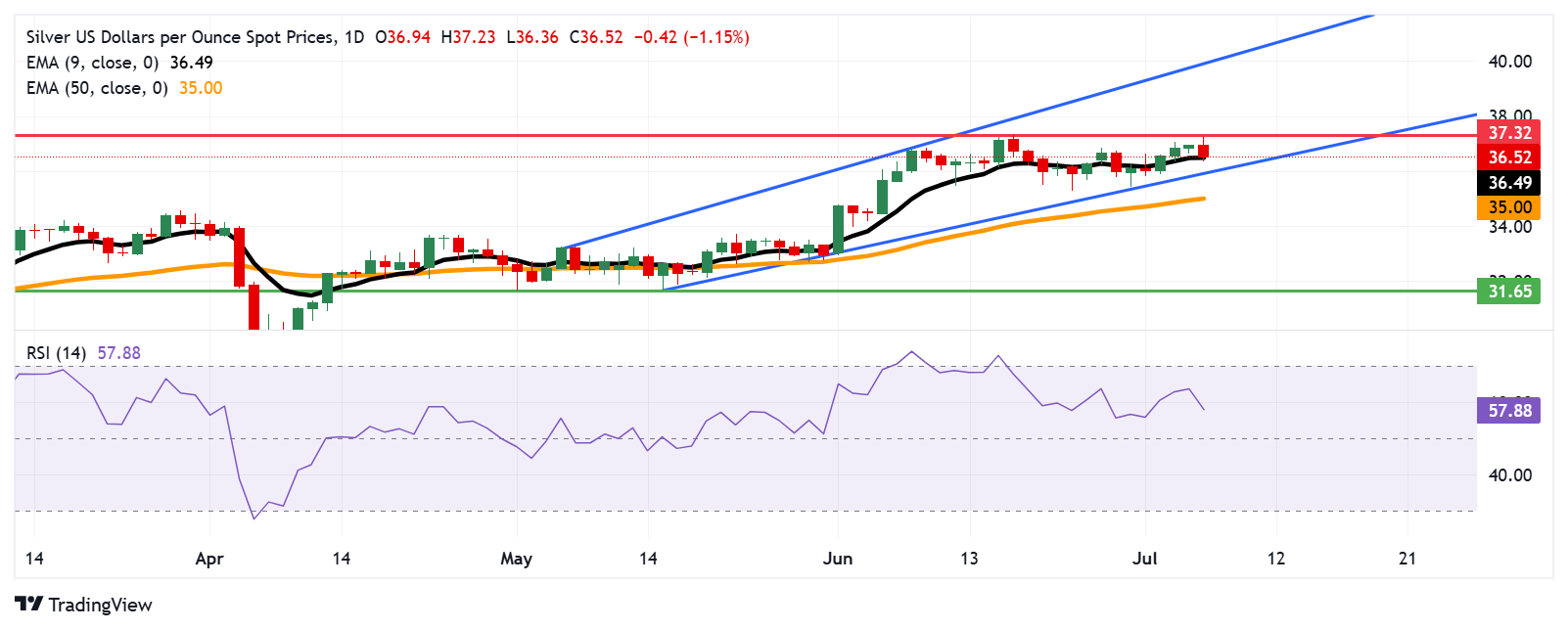Silver Price Forecast: XAG/USD tests $36.50 near nine-day EMA support
- Silver price may approach $37.32, the highest since February 2012.
- The bullish bias strengthens as the 14-day Relative Strength Index holds above the 50 mark.
- The nine-day EMA at $36.49 acts as the immediate support.
Silver price (XAG/USD) edges lower after halting a three-day winning streak, trading around $36.50 per troy ounce, down by more than 1%, during the European hours on Monday. The technical analysis of the daily chart suggests the price of the precious metal remains within an ascending channel pattern, indicating a bullish bias is prevailing.
The 14-day Relative Strength Index (RSI) remains above the 50 level, strengthening a bullish outlook. However, Silver price is trading slightly above the nine-day Exponential Moving Average (EMA), but appears poised to break below it, indicating potential weakening of short-term price momentum.
On the upside, the XAG/USD pair may retest $37.32, the highest since February 2012. A successful breach above this level could support the Silver price to explore the region around the upper boundary of the ascending channel around the psychological level of $39.90.
The Silver price is testing the immediate support at the nine-day EMA of $36.49. A break below this level could weaken the short-term price momentum and put downward pressure on the pair to navigate the area around the ascending channel’s lower boundary at $36.00 level, followed by the 50-day EMA at $35.00.
Further declines would weaken the medium-term price momentum and prompt the price of Silver to navigate the region around the two-month low at $31.65, which was recorded on May 15.
XAG/USD: Daily Chart

Silver FAQs
Silver is a precious metal highly traded among investors. It has been historically used as a store of value and a medium of exchange. Although less popular than Gold, traders may turn to Silver to diversify their investment portfolio, for its intrinsic value or as a potential hedge during high-inflation periods. Investors can buy physical Silver, in coins or in bars, or trade it through vehicles such as Exchange Traded Funds, which track its price on international markets.
Silver prices can move due to a wide range of factors. Geopolitical instability or fears of a deep recession can make Silver price escalate due to its safe-haven status, although to a lesser extent than Gold's. As a yieldless asset, Silver tends to rise with lower interest rates. Its moves also depend on how the US Dollar (USD) behaves as the asset is priced in dollars (XAG/USD). A strong Dollar tends to keep the price of Silver at bay, whereas a weaker Dollar is likely to propel prices up. Other factors such as investment demand, mining supply – Silver is much more abundant than Gold – and recycling rates can also affect prices.
Silver is widely used in industry, particularly in sectors such as electronics or solar energy, as it has one of the highest electric conductivity of all metals – more than Copper and Gold. A surge in demand can increase prices, while a decline tends to lower them. Dynamics in the US, Chinese and Indian economies can also contribute to price swings: for the US and particularly China, their big industrial sectors use Silver in various processes; in India, consumers’ demand for the precious metal for jewellery also plays a key role in setting prices.
Silver prices tend to follow Gold's moves. When Gold prices rise, Silver typically follows suit, as their status as safe-haven assets is similar. The Gold/Silver ratio, which shows the number of ounces of Silver needed to equal the value of one ounce of Gold, may help to determine the relative valuation between both metals. Some investors may consider a high ratio as an indicator that Silver is undervalued, or Gold is overvalued. On the contrary, a low ratio might suggest that Gold is undervalued relative to Silver.

